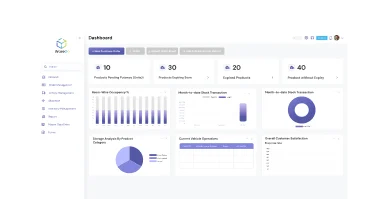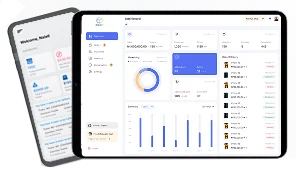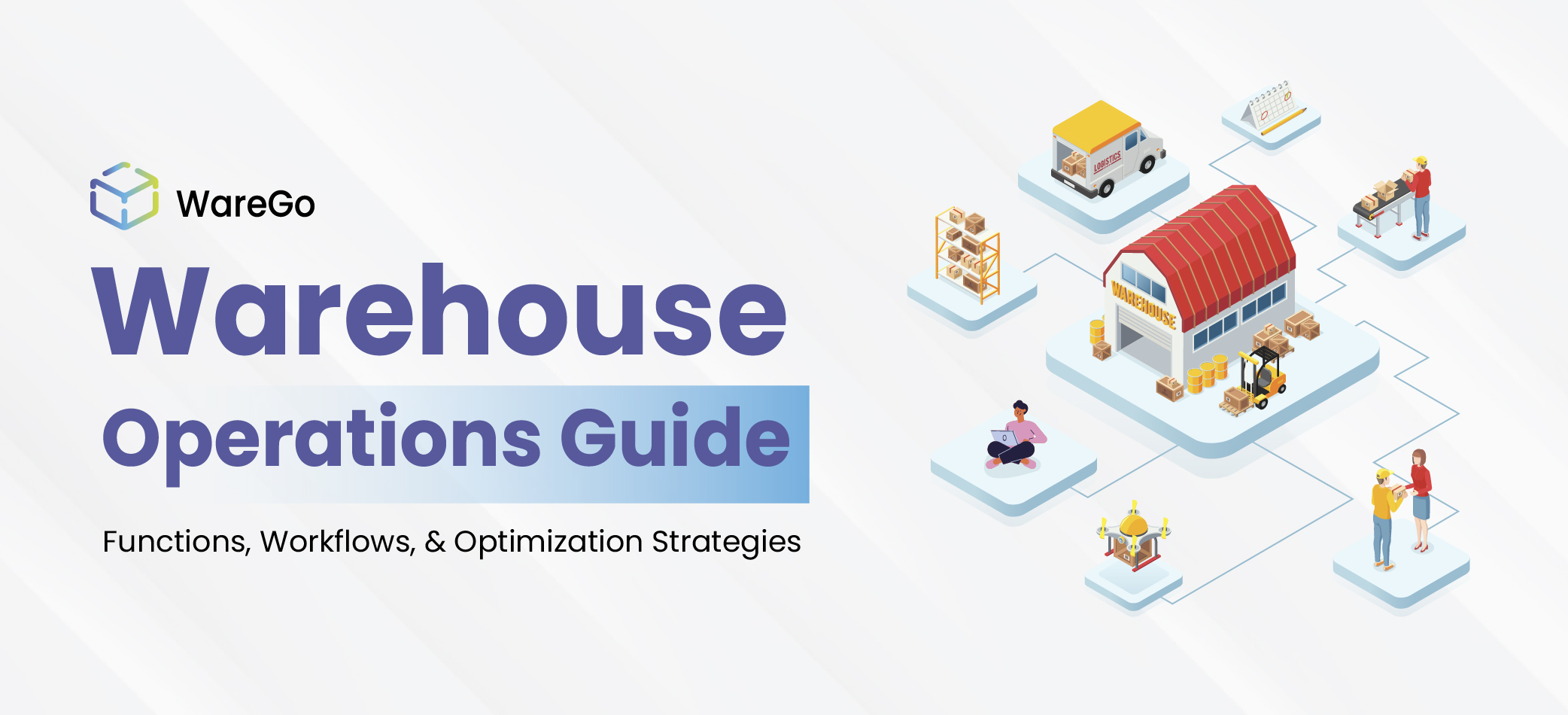
Warehouse operations are all about speedy and accurate fulfillment of orders. Warehouse operations are coordinated processes that control how goods enter, move through, and leave the storage facility. Optimal warehouse operations not only bridge inventory flow or labor gaps with automation but also shrink costs, improve consistency, and allow human efforts to be more focused on strategic aspects.
The global warehouse market is expected to grow to over $1.17 trillion by 2025, which also indicates the fact that 90% of the warehouses are anticipated to integrate WMS in order to optimize warehouse operations.
Table of Contents
What are Warehouse Operations?
Warehouse operations are a set of processes for end-to-end goods management within a warehouse. It includes everything from inventory arrival from the supplier to final dispatch to the customer, retailer, or distributor, and sometimes even the returns. The entire workflow is designed and optimized to maintain the highest levels of accuracy and traceability.
On the functional layer, warehouse operations cover:
- Inbound processes like receipt and inspection of new inventory.
- Internal processes like storage, inventory control, and order picking.
- Outbound processes like packing, shipping, and reverse logistics.
Each function of warehouse operations is governed by predefined policies, whereas specialized warehouse management software lead to smart, automated fulfillment.
For instance, consumer electronics warehouse operations include functions like incoming shipment scans, product stacking in assigned zones, batch-picking for new orders, and automated cartonization for cost control. In compliance-heavy sectors like pharma, warehouse operations add up with additional functions like lot tracking, temperature monitoring, and audit-ready documentation.
WareGo’s WMS replaces inefficiencies with automation, real-time visibility, and error-free workflows. Cut costs while scaling operations.
Request a WMS DemoTypes of Warehouse Operations
Warehouse operations differ with warehouse types that include factors like ownership, functions, and technology. Cost, processing speed, inventory control, and order flow vary according to the type of operation facility. Warehouse type directly defines the type of warehouse operations. Businesses must choose the right type of warehouse operations that perfectly complements inventory turnover, order complexity, demand patterns, and budget.
Here are the 5 core types of warehouse operations:
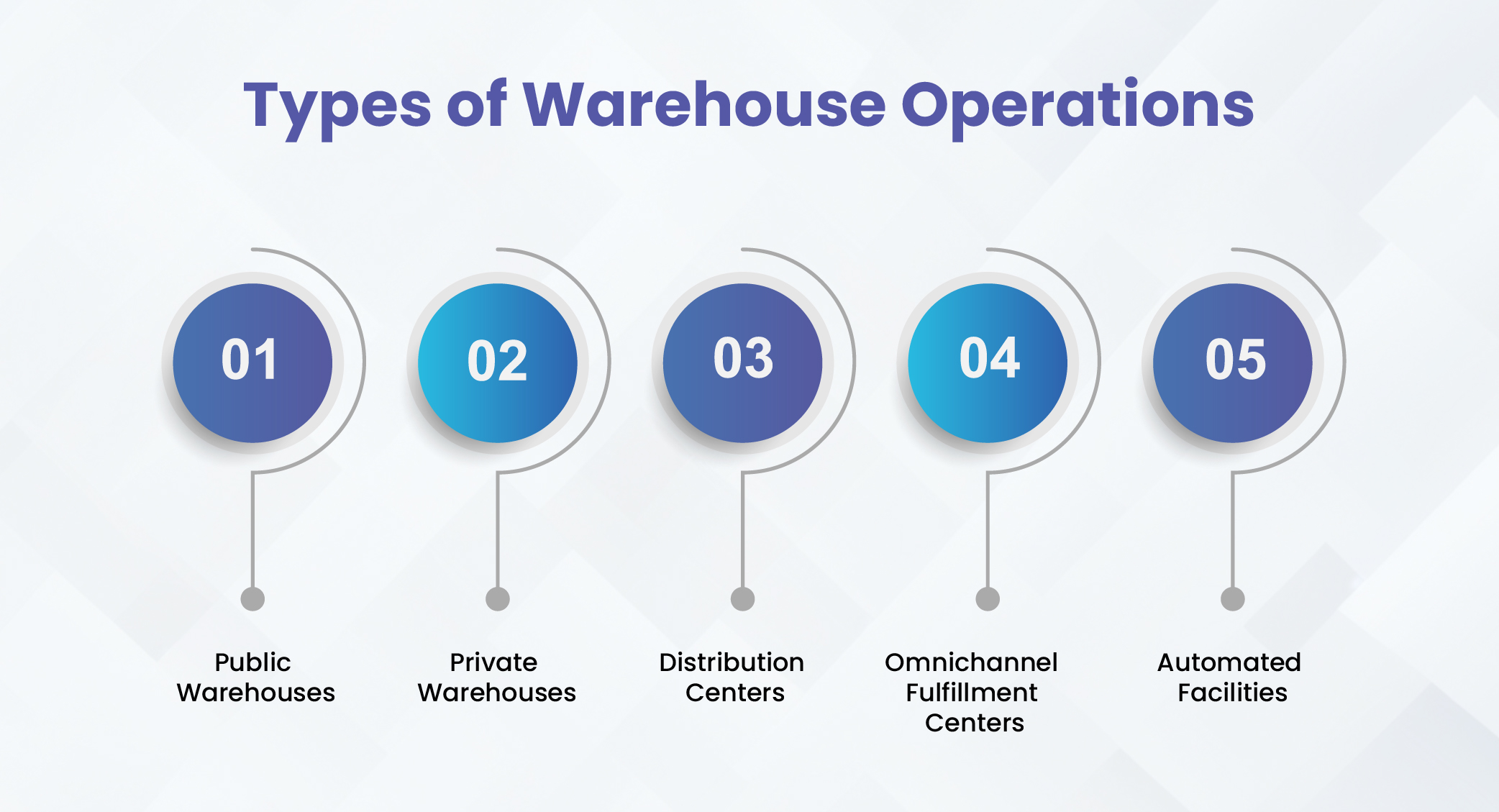
Public Warehouses
A public warehouse is a shared storage leased by a third party to multiple clients. It’s optimal for SMBs or businesses with no private storage facility. The space is billed for per square foot or pallet positioning with services including receiving, storage, and distribution that could be topped up with additional services like security or climate control.
Public warehouses need adaptable workflows and high-end warehouse management solutions to manage varying product mixes and turnover rates across clients, as they are commonly used for seasonal surges, cross-docking, or overflow from private facilities.
Private Warehouses
A private warehouse is owned and operated by a single business for exclusive inventory management. Private facilities give total control over storage layout, workflows, and compliance standards to high-volume businesses. For automation and optimizing warehouse operations, businesses get authority over wms selection and customization for accelerated turnarounds and accuracy.
It takes high capital investment but brings freedom as well, with lower long-term per-unit cost at scale. And businesses can directly integrate the warehouse operations with procurement, production, and customer service functions.
Distribution Centers
Dedicated distribution facilities focus on rapid throughput with minimal storage time. Distribution centers usually maintain 24-72 hours of turnaround time as they receive large shipments, break them into smaller ones, and quickly deliver them to retailers and direct consumers.
These centers are often used for cross-docking to bypass costly storage and manage high SKU counts with zone-based or automated picking using WMS to sync inbound flow and outbound schedules.
Omnichannel Fulfillment Centers
Omnichannel facilities serve multiple sales streams, including retail, e-commerce, and B2B, from a single location for mixed order profiles from single-unit shipments to full pallets.
WMS enabled with real-time updates keeps omnichannel centers up and running without cross-stream conflicts. These facilities work on lean slotting strategies that position fast-moving e-commerce goods near packing areas and bulk stock in pallet racks.
Also, these centers optimize warehouse operations by using relevant picking and delivery methods for each particular stream to maintain SLAs without overstocking and shortages.
Automated Facilities
Automated facilities go one step further than just integrating WMS for optimizing warehouse operations by shifting manual dependency to robots, including AS/RS, AMRs, robotic picking arms, and automated sortation systems.
Automated warehouse facilities are suitable for large-scale e-commerce or manufacturing supply hubs, as they need high investment for modern infrastructure and AI-powered warehouse management solution to set up. These facilities help integrate Six Sigma in warehouse operations for managing high-volume operations with optimal slotting and sequence and without conventional human interference.
Related Read: Types of WMS
Warehouse Operations Workflow
Warehouse operations workflow consists of multiple, well-crafted steps that take care of inventory from arrival to departure with near-zero delays and errors. Workflow efficiency is achieved by integrating process optimization techniques like Six Sigma in warehouse operations and top-tier WMS integration to make the best use of labor, space, and time for compliance and traceability.
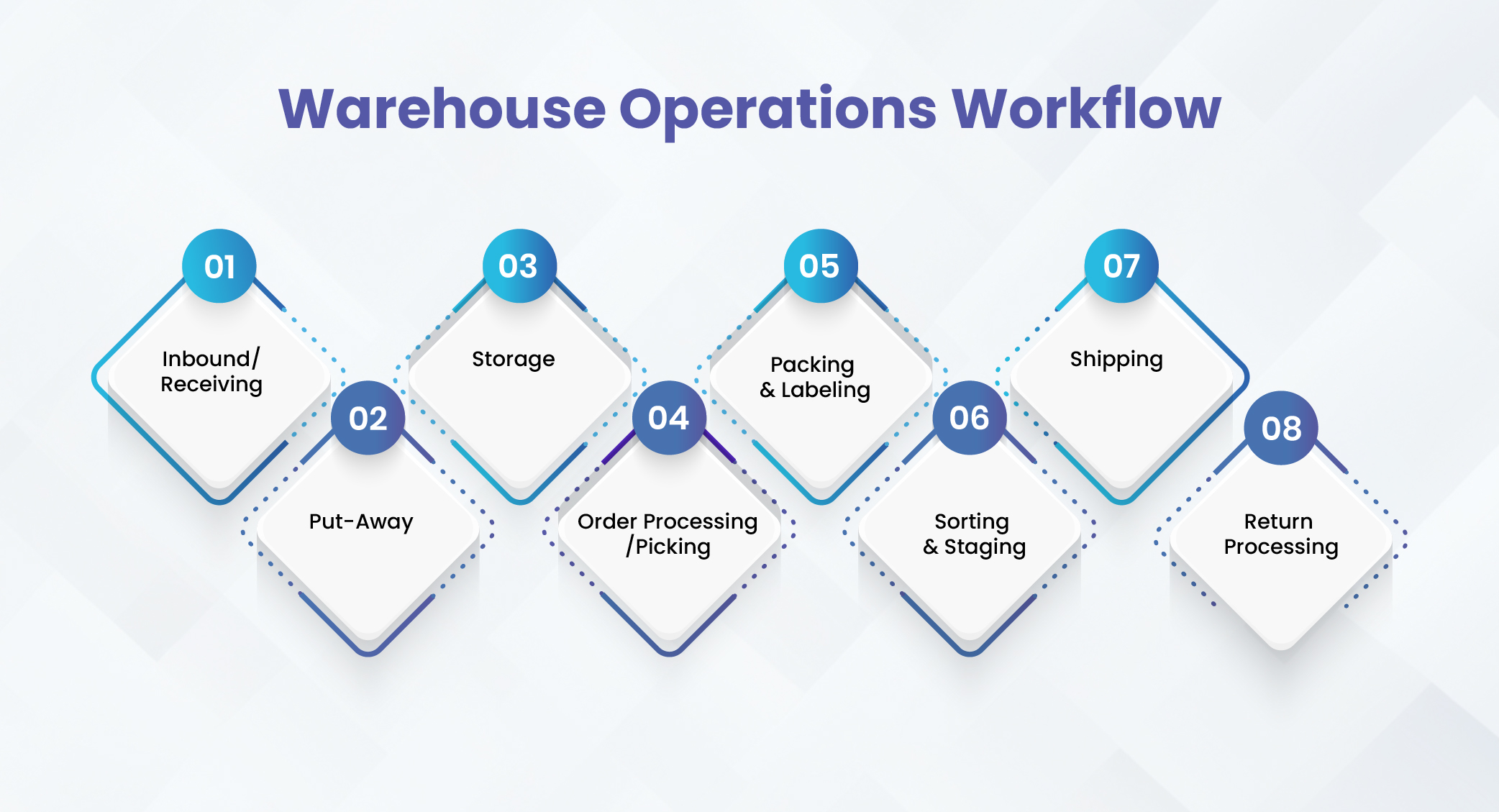
Inbound/Receiving
The warehouse operations checklist begins with the inbound stage at the loading dock, where trucks arrive from suppliers or production sites. Every shipment gets transferred to the assigned bay using forklifts, pallet jacks, and conveyor systems.
The entire load is verified by the receiving team for quantity and SKUs against the purchase orders and advance shipping notices (ASNs) to rectify discrepancies or damages that are recorded and flagged for supplier resolution on the spot.
Verification passes goods are scanned through barcode or RFID to create a live inventory record in WMS. Based on the types of warehouse operations, each carton is measured manually or through automated dimensioning systems for precise storage. WMS uses this data to generate a put-away plan for efficient inventory management without human effort. Optimized receiving eliminates mismatch errors between physical and system inventory that keep the warehouse operations process smooth.
Put-Away
The second state in the warehouse operations process is to move the assigned storage locations and slots determined by WMS. Items are placed by demand frequency, dimensions, handling requirements, and the proximity of picking zones that help put high-turnover goods closer to picking areas and slow-moving stock to higher or distant racking.
Floor operators get instructions on handheld or voice-guided devices for goods placement and use selective pallet racks, flow racks, shelving, or automated storage and retrieval systems (AS/RS) to do so. Right after placement, product location is scanned and updated to the warehouse digital map to cut unnecessary hassle and accelerate accurate order fulfillment even during high demand.
Storage
Storage is an active function to keep goods with maximum space efficiency and accessibility. For optimal storage, warehouses are divided into zones based on product type, turnover rate, or environmental/temperature-controlled needs.
FIFO and LIFO methods are commonly used for optimal inventory rotation based on expiration and perishability. For example, FIFO is commonly used for food, pharmaceuticals, and cosmetics shipping, and LIFO is used for non-perishable goods or where cost accounting and storage layout make it more practical.
Technology plays a little more here as WMS applies rotation rules automatically, with perpetual tracking and cycle counts. AS/RS systems reduce manual handling. All of these lead to efficient storage planning, maximum accessibility, and order dispatch accuracy while staying compliant with quality standards.
Order Processing/Picking
Order picking usually eats up nearly half of the warehouse operational expense. Zone picking, wave picking, or batch picking methods are used based on the dispatch-efficiency ratio.
Picking staff use handheld devices, voice systems, or pick-to-light technology for assistance, while task completion is instantly recorded in the WMS. To automate warehouse operations, goods-to-person systems or picking robots are used, which also boosts efficiency during high-volume operations.
Order picking is more error-prone than any of the steps in the warehouse operations process, and to keep up with that, facilities track KPIs like picking accuracy, pick rate, and travel time, while missing or incorrect products are reported immediately.
Packing & Labeling
At the packing stages, orders are prepared for safe transport and correct delivery using automated cartonization based on product size and shipping info to reduce costs.
Orders are packed carefully using relevant material (protective or normal), then sealed and labeled with information including SKU, order number, destination, and tracking ID generated by WMS or ERP.
Print-and-apply machines automate warehouse operations of labeling for bulk delivery. Correct labeling effectively communicates the goods inside, like compliance labels on hazardous or food products, and also prevents damage and customs delays.
Sorting & Staging
Once orders are packed and labeled, they undergo the sorting process to be staged as per carrier, route, or priority. For small facilities, sorting is done manually using conveyor systems to direct packages into the correct lanes. Whereas at bigger warehouses, automated sorters scan labels to route items faster.
Staging is done near the shipping docks to ease order loading in trucks and reduce loading time and derisk departures. High-scale warehouse operations use separate docks for fast-tracking shipping or multi-carrier setups to manage optimal lead time and avoid additional freight charges.
Shipping
Shipping is the last checkpoint before orders leave the facility. WMS creates a loading plan using vehicle capacity, delivery sequence, and handling needs. Drivers scan packages to verify the load against these plans that flow back shipping status updates into the WMS to trigger customer notifications and the billing process.
Warehouses use dock schedules to smoothly manage truck arrivals and departures with minimal wait times. On the other hand, customs documentation is integrated for international orders within WMS for quick clearance. Accuracy at this stage of the warehouse operations process directly influences fulfillment performance and customer satisfaction.
Return Processing
Returns are as critical as outbound orders, as every item needs to be inspected on arrival to determine if it can be restocked, repaired, or discarded. Returned products that are suitable for resale get back to the current inventory to maintain stock accuracy.
Returns are controlled in a dedicated area to prevent mix-ups with outbound goods. WMS records return reasons and turns that data into analytics for quality checks to further optimize warehouse operations.
For example, a high rate of damaged returns signals packaging issues, while frequent wrong-item returns point to picking errors. Quick order return resolution reduces write-offs and optimizes inventory health.
Integration with ERP, shipping, and e-commerce platforms is built into WareGo’s WMS for seamless end-to-end visibility.
See WMS in ActionRole of Warehouse Operations in Supply Chain Management
Warehousing is not just a passive storage; it’s a control point that directly impacts service levels, working capital needs, and landed cost. Solid warehouse operations shorten order cycles, reduce expediting, and protect margins, which makes the overall supply chain lean and efficient.
Here’s how optimizing warehouse operations actually comes into play at different levels and also boosts Six Sigma practices in the supply chain:
Buffer Variability
Optimized warehouse operations absorb upstream and downstream shocks. If suppliers ship anything off the schedule, clear warehouse operation processes prevent demurrage and yard congestion. And if demand spikes, forward pick buffers, pre-waved orders, and flex labor keep the floor moving.
Synced Flow
Bottlenecks happen at handoffs. Cross-dock directives taken under optimal warehouse management move pre-allocated POs directly to outbound lanes and bypass the storage needs. For interleaving pairs, assign put-away and replenishment together so each forklift trip moves products in both directions and eliminates travel waste. Stage pallets in a sequence; they’ll be loaded to skip reshuffling pallets, reducing trailer dwell time.
Visibility & Agility
A shared data layer across WMS and ERP gives a clear, live overview of current inventory, carrier cutoffs, and capacity. The visibility across warehouse operations helps quickly adapt to sudden challenges that may require re-promising urgent orders, shifting stock across locations to fulfill demand, and re-sequencing outbound shipments by carrier performance. Warehouse operations leverage visibility and agility significantly in SCM to maintain commitments and tackle difficulties without a cost surge.
Strategic Response
Disruptions occur even in well-run warehouses. And it can be anything, such as a carrier missing a pickup due to sudden demand spikes or delays from suppliers.
Optimized warehouse operations help proactively address each scenario and resolve issues through quick parcel rerouting, reallocating labor to bottleneck zones, and pre-positioning inventory closer to demand, keeping supply chain operations above par throughout the cycle.
Related Read: Warehouse Software Cost
Common Challenges in Optimizing Warehouse Operations
Internal and external issues can arise at any point even if everything looks to be running smoothly from an eagle eye. Some issues may underlie operational control and some be influenced by the external forces, but a clear view from the managerial perspective is always necessary for improving warehouse operations.
Labor Shortages & Workforce Stability
Labor availability is uncontrollable and depends on the broader job market. However, retention and productivity are internal matters. Slow hiring cycles and costly on-the-job training sometimes leave gaps that impact overall throughput. This gap can be filled by automating warehouse operations from redundant tasks and cross-training programs to reduce dependency on a single role and eliminate operational slowdown even during absences.
Inefficient Space Utilization
Businesses cannot control the rising rents, but they can make the most of available space. Poor slotting, oversized storage areas, and unused vertical capacity increase travel distances and slow picking. Instead, integrating optimal network modelling, dynamic slotting tools, and high-density storage systems increases capacity without moving to a larger facility.
Legacy Technology Limitations
A modular upgrade is necessary at this stage, as it helps improve warehouse operations. Businesses can slightly shift data and operations in phases to a top-tier WMS without causing disruption among the users and day-to-day tasks.
Capital Constraints for Modernization
Legacy software or outdated WMS in most warehouses often lacks API integration, real-time inventory sync, and AI compatibility. Instead of optimizing warehouse operations, inefficient legacy systems might limit agility and slow decision-making.
Optimization isn’t just limited to applying Six Sigma in warehouse operation but also to deploying modern equipment for automation and scalability, which definitely requires massive upfront spending.
Sequencing projects by ROI and operational impact gets faster payback. For example, starting with autonomous mobile robots for transport or automated print-and-apply stations can deliver measurable cost savings in under two years.
Process Bottlenecks & Poor Task Coordination
Inefficiencies in how tasks are assigned and coordinated cause delays even after having optimal labor count and space. Processes with sequential workflows, excessive manual efforts, and disconnected scheduling create avoidable bottlenecks.
Such scenarios require task interleaving, wave re-sequencing, and real-time workload balancing to cut idle time and improve warehouse operations.
Sustainability & Energy Efficiency Demands
Sustainability is a permanent consideration, especially during growing customer expectations and regulatory standards. Energy prices and mandates are external affairs, but efficiency gains are internal choices to keep up with the standard practices.
Energy-efficient practices aren’t meant to be limited to CSR only to impress the general audience once a year but must be adopted as a tactical approach to cost and process optimization.
Businesses must fill gaps in the current infrastructure, like LED lighting upgrades, HVAC zoning, dock door air curtain installation, or right-sized refrigeration, to improve environmental performance and gain a competitive edge without compromising service quality.
Warehouse Operations Best Practices
Engineer efficiency into every process, system, and layout decision. Efficient warehouse operations merge technology, automation, predictive capabilities, and skilled people into a coordinated system for consistent, accurate performances. Here’s how to improve warehouse operations with a proper course of action for each segment of the warehouse processes.
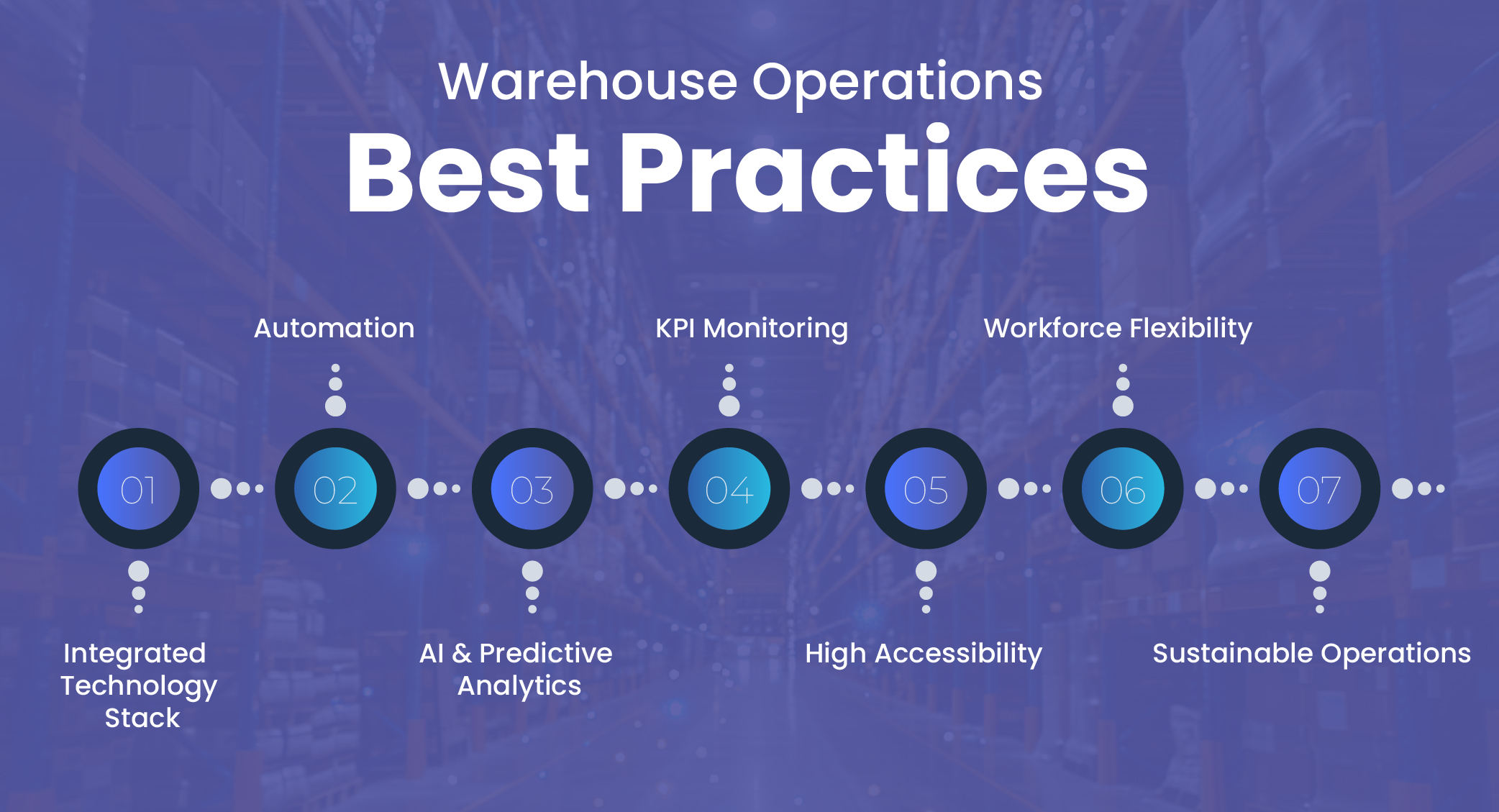
Deploy an Integrated Technology Stack
Connect WMS, ERP, and labor management systems through a single data backbone. Seamless connectivity across workflows runs on the same, accurate information. Standardized event codes and enforced API performance agreements keep data consistent and actionable.
Automate for Accuracy & Speed
Automate inefficient warehouse operations first; that will surely deliver the highest return after implementation. For example, integrate autonomous mobile robots (AMRs) to move pallets faster, adopt AS/RS systems for increased storage density, and use print-and-apply machines for reduced labeling errors.
For smaller-item orders, piece-pick robotics make sense where SKU shapes and volumes align. Start with making small changes, prove the technology shift ROI, and expand as per results.
Use AI & Predictive Analytics
Predictive tools help allocate resources before issues arise. AI-readiness helps forecast order volume by the hour, anticipate congestion in specific zones, and schedule labor around peak demand to improve warehouse operations. AI also helps predict maintenance cycles based on equipment usage rather than fixed intervals, which eventually reduces usual downtime for conveyors, shuttles, and other critical assets.
Monitor KPIs in Real Time
Link system alerts to predefined playbooks to trigger quick actions. For example, automatically indicating actions like opening a lane, adding pickers, or re-sequencing waves when a threshold is reached. Optimize dashboards and conduct regular audits to keep alerts quick and effective for smooth warehouse workflow.
Design for Flow & Accessibility
Physical layout impacts the speed and safety of warehouse operations. For optimizing warehouse operations, place high-velocity items closer to packing and docks, keep A/B/C movers separated to prevent aisle congestion, and stage pallets in the order they’ll be loaded to avoid rehandling. Continuous re-slotting practice keeps the layout aligned with changing demand and order dispatch rates.
Build Workforce Flexibility
Flexible staff outshine operations in any challenging situation. Cross-train employees for multiple similar areas like picking, packing, loading, and replenishment so they can shift when there is a need or bottleneck in any alternative section. Put cross-functional details on WMS and use on-device checklists and standardized SOPs for consistent output even when roles change mid-shift.
Commit to Sustainability as a Standard
Adopt energy efficiency like any other operational KPI. Start sustainable transformation with LED lighting upgrades, following HVAC zoning to optimize climate control, and adding solar energy generation where viable. Use a modular monitoring approach in every zone to pinpoint energy waste and narrow actions for precise fixation.
Our WMS improves order picking accuracy and reduces returns through real-time data and guided workflows.
Try Our WMS DemoWarehouse Operations Optimization Strategies
Optimizing warehouse operations needs a structured, continuous improvement cycle. Tested optimization strategies refine practices through data discipline, lean methods, and precision tools like Six Sigma in warehouse operations.
Here’s how to improve warehouse operations to handle greater loads with strict lead time maintenance.
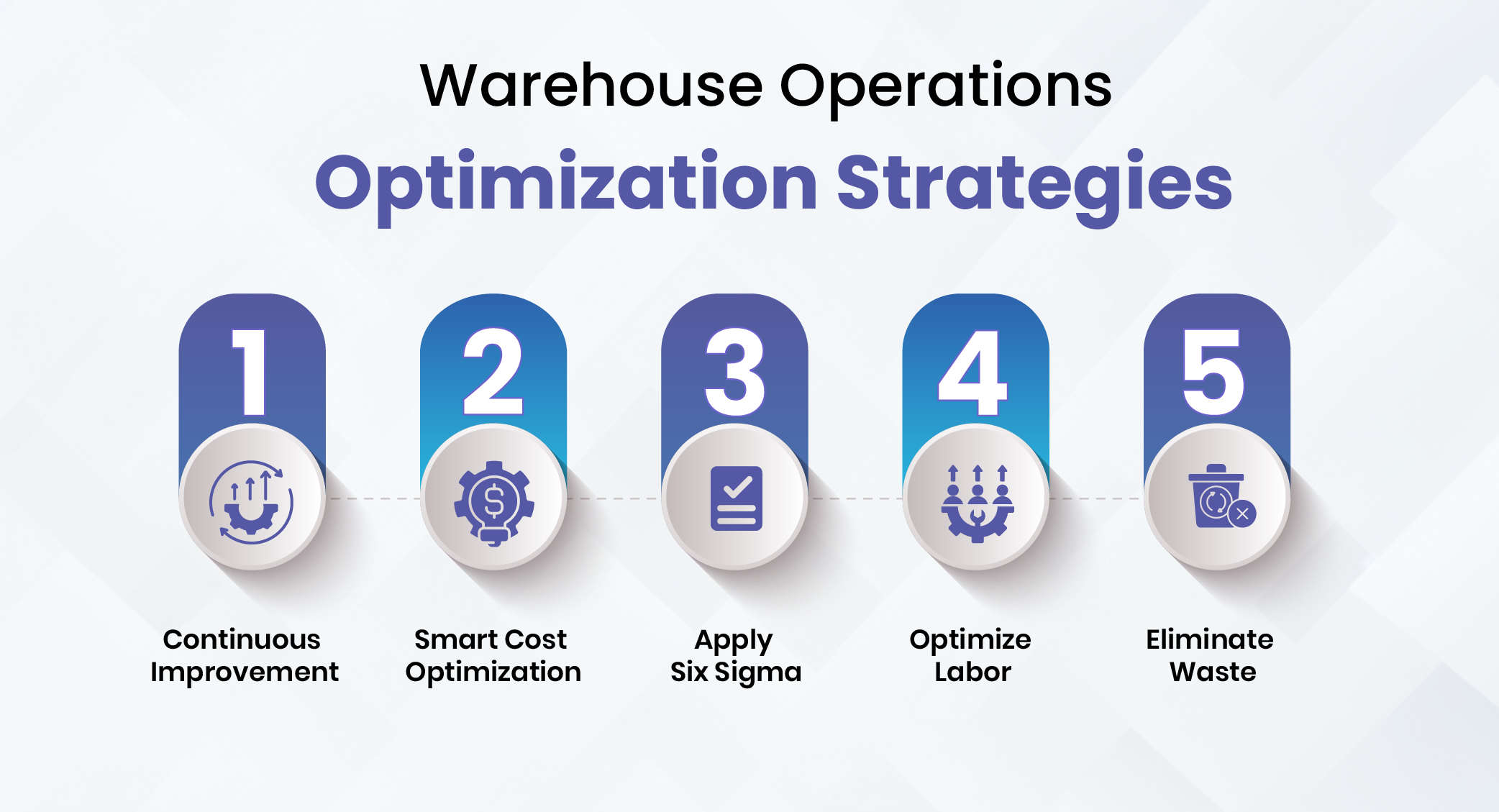
Build a Continuous Improvement Framework
Improving warehouse operations needs a structured framework like Lean or Six Sigma to evaluate performances constantly.
For example, weekly dock-to-stock time checks or having monthly Kaizen workshops evolve processes with customer demand. Warehouse managers must test new slotting layouts, reduce unnecessary touches, and remove bottlenecks as a routine task instead of waiting for a major disruption to trigger change.
A warehouse trained to improve itself every month definitely outperforms one that only reacts to crises. Continuous improvement keeps warehouse operations agile, scalable, and prepared for unexpected shifts in supply chains or customer demand.
Embed Cost Optimization in Daily Decisions
Cost optimization must step out of budget meetings into everyday operations. Every activity in a warehouse costs something. That includes travel time per picker, packaging, energy usage, and even delayed shipments.
All the best warehouse operations practices we have discussed above, including modern slotting, cartonization software to reduce shipping surcharges, and zone-level energy sub-metering to identify where HVAC or lighting is draining money, are part of cost optimization.
Supervisors must track metrics like “cost per order line” or “cost per shipment” on WMS in real time to make cost control actionable. Continuous measures transform cost-cutting exercises and free up capital for expansion, technology upgrades, or competitive pricing.
Implement Six Sigma for Process Control
Six Sigma isn’t just limited to manufacturing facilities; it works best in warehouse operations too. Six Sigma in warehouse operations reduces variation that leads to fewer miss-picks, faster order cycles, and better compliance.
For example, if businesses visualize/map workflows in a fishbone diagram, it will highlight unnecessary touches or bottlenecks to help uncover why problems repeat. It’s also important to train staff as Six Sigma Green Belts for in-house expertise that would help in more focused work and cut errors significantly. Unlike generic practices, Six Sigma adds structure and discipline for continuous improvement that results in high productivity, better ROI, and definitely greater customer satisfaction.
Optimize Labor Through Continuous Feedback
Labor often incurs 50–60% of warehouse operating costs. Traditional static schedules aren’t smart enough to adjust labor as per daily volume fluctuation. Instead, use predictive or AI-powered tools to forecast peak hours and assign labor precisely as per the need.
Integrating labor data into real-time dashboards tracks inefficiencies that help supervisors with instant scheduling. Along with calling for daily huddles to resolve day-to-day issues, also conduct cross-training along with daily huddles to not just resolve day-to-day issues but inject flexibility in staff for cross-role shifts during high demand at specific warehouse functions.
Incentivize staff on accuracy and speed to encourage balanced performance. Do not just use these practices as a once-in-a-year thing, but adopt them as a regular part of operation with continuous feedback to keep the teams’ morale high and drive consistent performance.
Make Waste Elimination a Standard KPI
Excess travel, re-handling, damaged returns, packaging inefficiencies, or even unnecessary energy use are common types of waste in warehouse operations. To cope with them, add waste reduction to daily KPIs for systematic process improvement. Audit operational waste every quarter to keep track.
Making waste management an SOP creates a culture of vigilance among all warehouse staff that results in a twofold benefit, i.e., lower costs and higher operational efficiency without adding headcount or capital.
Warehouse Optimization Is the New Competitive Advantage
A warehouse operation directly impacts the supply chain, which means it shapes the cost structure, process speed, and customer satisfaction. Businesses that focus on continuous improvement in inventory accuracy, process control, and labor productivity gain faster cycles and stronger margins.
If your process is more reactive than strategic, it is time to improve warehouse operations. In this case, a modern, reliable Warehouse System works as a major force to turn things around. Book a demo today and discover how to improve warehouse operations with a top-tier WMS.
Manual updates waste hours and cause errors. Experience a WMS built to replace outdated, risky spreadsheets with real-time control.
Request DemoFAQs
What are warehouse operations?
Warehouse operations are end-to-end activities that handle goods right from receival to exit from the facility. The entire warehouse operations process includes intake, storage, order picking, packing, and outbound shipping of products with accuracy, efficiency, and customer satisfaction.
How to optimize warehouse operations?
Optimization means continuously improving warehouse operations for minimum waste, greater accuracy, and efficiency at every stage. Automation for repetitive tasks, WMS integration, AI/predictive tools, and Six Sigma application are a few of the major steps that businesses must take to control and optimize warehouse operations.
What are the functions of warehouse operations?
Inbound receiving, internal storage, inventory control, order picking, outbound packing, shipping, and reverse logistics are core warehouse functions. Every stage is interconnected, and efficiency throughout these functions drives overall operational success.
What are the 5 warehouse processes?
5 core warehouse processes are receiving, put-away, storage, picking, and shipping. Combining these processes forms the warehouse workflow.
What do warehouse operators do?
Warehouse operators are the daily drivers of all warehouse functions and manage everything that takes place in between unloading shipments from suppliers and sending orders to the clients.
